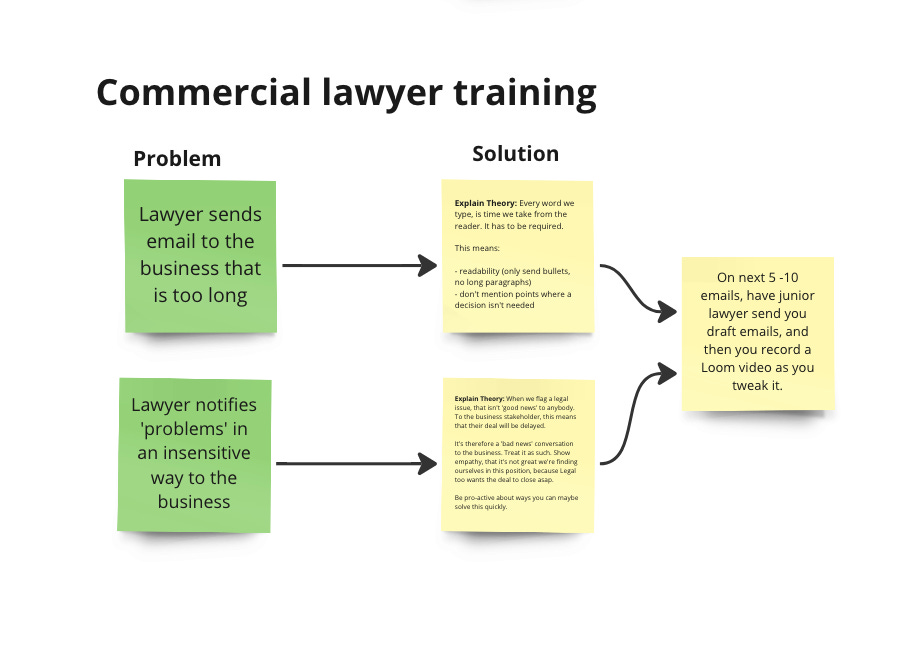How to train junior lawyers to write better emails
When I was a junior lawyer I often made two mistakes in my emails:
they were too long: long paragraphs, too much signalling of all the work I had done, etc.
poor bedside manner: I brought legal issues with a sense of pride “look at all these issues I found, I’m a good diligent lawyer!” (but in the client’s mind this is tone deaf, it’s all just ‘bad news’ getting in the way of closing the deal - so issues need to be presented with care).
Over time I learned non-lawyers simply refuse to read long emails. My co-founder Chris is one of them :-). He’d ask a question and I’d say, “but I had already mentioned that in the fourth paragraph?”. Then he’d shrug and reply “Yeah, sorry, but I couldn’t really bring myself to read all that”. Quite the reality check!
I also learned painful lessons on how I brought issues to the business’ attention. When I was a junior lawyer, I was seconded to a big energy company in Brussels. The business was trying to close a big deal. They said they had commercially agreed, just needed legal (i.e. me) to eyeball the counterparty’s suggested changes. They really wanted me to say it was all fine.
And… I wrote them a long issues list with everything I thought was wrong. No solutions. Just problems. Suffice to say, I didn’t get a pat on the back for spotting all those risks! They looked at me with disdain and a feeling of embarrassment washed over me. My legal analysis was sound, but my delivery atrocious.
It took me a few years to learn how to not fall into these traps. But it shouldn’t have to take that long.
Here’s how to train junior lawyers in weeks, not years:
At Lexoo, we regularly hire in-house lawyers to negotiate BAU contracts for our clients. That means we need to do a lot of training to make sure we all write emails that are to the point.
Here’s our training process:
Explain the theory: I tell the above stories and explain that every word we type is time taken from the recipient. So each word needs to have ‘earned’ it’s right to be there. Rough rules of thumb:
Only mention points where a decision or action is needed, no need to justify our own existence! For any decisions, try to suggest solutions they can say yes/no to, instead of open-ended questions.
For unexpected issues, make sure to show empathy and that you care about doing the deal.
E.g. instead of: The indemnity is completely unacceptable. We need to push back hard.” write: “Unfortunately the indemnity is creating quite a bit of exposure for us. I understand the urgency of the deal so I propose we compromise in the following way, so that the closing date doesn’t slip.” This makes the reader feel you care about their goals.
Then show them: the theory is necessary but not sufficient. As trained professionals, we have deep grooves in our brain to work a certain way. It takes conscious effort to snap out of them and create a new groove. How to do this:
All learning is painful, so get your team member excited to learn: Explain that learning this skill will make clients and business stakeholders love working with them and it’ll set them apart as a great commercial lawyer for the rest of their careers.
Review: Suggest that for the next 5-10 emails they send you a draft first. Then record a Loom video (which records your screen) of you adapting the draft. This means you can easily talk out loud and explain with each change (even minor ones) why you made it. Then send back the revised draft with the link to the Loom video. Takes minutes!
I’ve found that after 5-10 emails you’ll see a big change. Here’s a chart summarising this:
Hope you found this helpful!
Best,
Daniel
Reminder: Join me for a free workshop
Last week’s post covered using a risk matrix to negotiate what matters. I’m going to work through the matrix in a live workshop on Wednesday 9 August at 4:30pm (UK).
You can sign-up to join here via LinkedIn! You’ll get the recording afterwards too (even if you can’t make it on the day).
During the live workshop:
we’ll work through the Risk Matrix for a contract type in a collaborative way.
I’ll also show you the moving parts to the workshop, so you’ll feel confident running it for your own team as well.
Hope to see you there!




